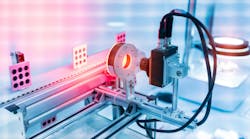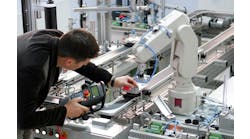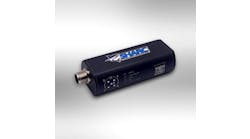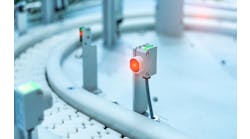As we move into a digitalized world filled with new technologies, the movement toward smart sensors—those that can and do talk to the Internet, the cloud and the edge—is gaining popularity almost exponentially.
Remember that applications for these also include “dumb” or analog devices.
Robotics
Position sensors play a crucial role in robotics by providing information about the location, orientation and movement of robotic components. These sensors enable robots to navigate, manipulate objects and interact with their environment. Here are several ways in which position sensors are used in robotics:
Robotics application 1—Joint position sensing: For these applications, rotary or linear encoders, potentiometers, resolvers are used. Robots have joints that move in various ways, such as rotational or linear motion. Position sensors attached to these joints provide feedback on the angles or positions of the joints. This information is essential for precise control of the robot's movements.
Robotics application 2—end-effector positioning: Here we use force/torque sensors, six-degrees-of-freedom (6DOF) sensors, vision systems. In terms of how these are applied, position sensors on the end effector—the tool or hand of the robot—help to determine its position and orientation in three-dimensional space. This is critical for tasks like pick-and-place operations, assembly and other applications requiring precise manipulation.
Robotics application 3—absolute and relative positioning: In this application, absolute encoders or relative encoders are employed. Absolute encoders provide the precise position of a robotic component, while relative encoders measure changes in position. Both types are used in robotics for tasks ranging from navigating within a workspace to controlling specific joint movements.
Robotics application 4—closed-loop control systems: A closed-loop control system uses feedback from a measurement device, a sensor. Position sensors are integral to closed-loop control systems. Feedback from the sensors is used to continuously adjust and control the robot's movements, ensuring accuracy and stability. Closed-loop systems correct errors and deviations from the desired position.
Robotics application 5—collision detection: For this we use force or torque sensors. Force/torque sensors on robot arms can detect unexpected contact with objects or obstacles. This information is crucial for implementing safety measures, preventing damage to the robot or its surroundings and enabling collaborative-robot (cobot) applications.
Robotics application 6—navigation: For navigation and odometry, wheel encoders or inertial measurement units (IMUs) are generally used. For mobile robots or autonomous vehicles, wheel encoders and IMUs help estimate the robot's position and orientation as it moves through space. This information is essential for navigation and mapping tasks.
Robotics application 7—sensor feedback signals for control algorithms: These can be various types of encoders or sensors. To move under control, the robot has position sensors which provide feedback to control algorithms, allowing robots to adapt their movements based on external stimuli or changes in the environment. This adaptive capability is crucial for tasks like obstacle avoidance and responding to dynamic environments.
Robotics application 8—orientation: Orientation control or dynamic balancing is achieved through the installation of inertial measurement units. These devices are used in balancing robots and humanoid robots to maintain stability by constantly measuring and adjusting the robot's orientation. This is particularly important for applications such as walking, climbing stairs or traversing uneven terrain.
Automated processes
Industrial position sensors include automation applications other than robots. Position sensors play a critical role in automation by providing real-time information about the location, movement and orientation of various components in a system. These sensors contribute to the efficiency, precision and safety of automated processes.
For instance, in the use of linear actuators and motors, linear encoders, linear variable differential transformers (LVDTs) are normally installed. These comprise position sensors attached to linear actuators or motors to provide feedback on the position of moving components. This information is crucial for controlling the linear movement of tools, conveyors or other automated systems.
For rotary motion control, we use rotary encoders, potentiometers or resolvers. These devices monitor the angle or rotation of various components, such as shafts, wheels or robotic joints. This information is essential for precise control of rotary motion in automated machinery.
In industry, conveyor systems are commonplace. How are they controlled? Photoelectric sensors or ultrasonic sensors fit this application perfectly.
Position sensors in conveyor systems detect the presence, location or movement of objects on the conveyor belt. This information is used to control the flow of materials, synchronize processes and implement sorting or indexing operations.
Pneumatic and hydraulic actuators make use of LVDTs and magnetostrictive sensors. Position sensors in pneumatic and hydraulic actuators monitor the extension or retraction of cylinders. This feedback is used for precise control in applications such as material handling, pressing or clamping.
In the world of instrumentation and control, closed-loop control systems are the primary choice for efficient manufacturing. In this case, various types of encoders or sensors are used. Feedback from the sensor allows continuous adjustment of motor speeds, positions or actuator movements, ensuring that the system follows the desired trajectory accurately.
Moving further into the heart of the industrial realm, when we consider what is commonly referred to as the machine shop or mechanical fabrication workshop, tool and workpiece positioning sensors are required. These are usually laser sensors or in recent times advanced vision systems. Here, position sensors are used to determine the position of tools or workpieces in machining or assembly processes. This information is crucial for ensuring precise alignment, placement and quality control.
In many applications we require the monitoring and control of material-handling systems. The most frequently used devices are normally photoelectric sensors, ultrasonic sensors or advanced vision systems, such as smart digital cameras.
Position sensors in material-handling systems detect the presence, position or dimensions of objects. This information is used to control the movement of materials on conveyors or guide robotic arms and facilitate automated picking and placing.
Automated guided vehicles (AGVs) are becoming somewhat extensively used, particularly in part stores and warehouses. The main contributors to control and management of these vehicles are magnetic sensors, vision systems or perhaps even laser sensors. Position sensors on AGVs help them navigate and follow predetermined paths. These sensors detect markers or guide lines on the floor, ensuring accurate and safe movement within a facility. They can also be controlled via actual coordinates from a global positioning system (GPS).
Safety
The No.1 application for any industry is safety systems. Typical devices used are safety light curtains, safety mats, proximity sensors or smart visual detection devices such as cameras. Position sensors are integrated into safety systems to detect the presence or movement of personnel within hazardous areas. These sensors contribute to the implementation of safety measures, such as emergency stops, to protect operators and prevent accidents.





